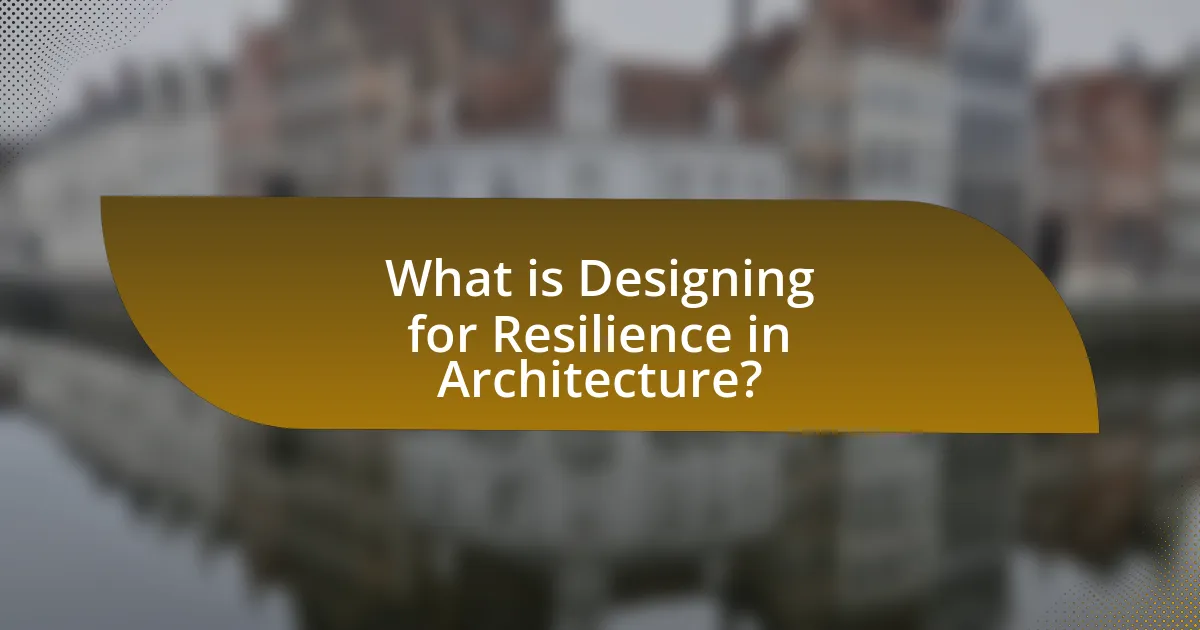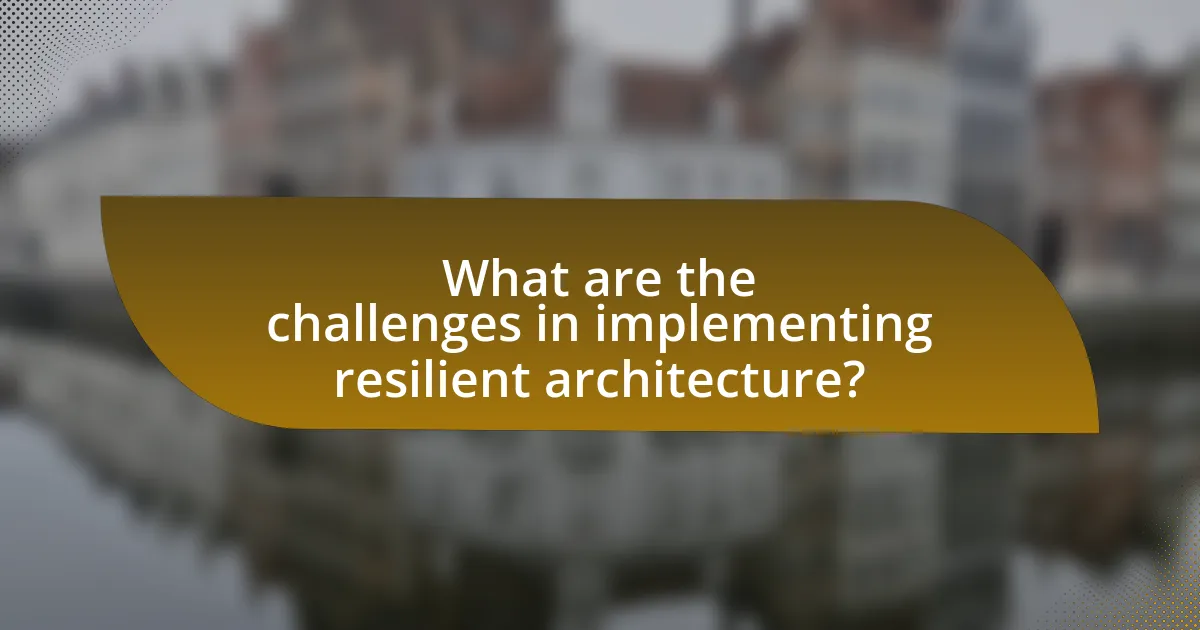Designing for resilience in architecture involves creating structures that can withstand and adapt to natural disasters and climate change impacts. This article outlines the principles of resilient architecture, including adaptability, redundancy, robustness, and sustainability, and discusses how these principles apply to various natural disasters such as earthquakes, floods, and hurricanes. It highlights the importance of using durable materials, effective site selection, and advanced engineering techniques to enhance structural integrity and reduce economic losses. Additionally, the article addresses the challenges and barriers to implementing resilient design practices, emphasizing the role of community engagement and government initiatives in promoting resilience in architectural practices.

What is Designing for Resilience in Architecture?
Designing for resilience in architecture refers to the practice of creating buildings and structures that can withstand and adapt to natural disasters and climate change impacts. This approach incorporates strategies such as using durable materials, implementing flexible designs, and integrating sustainable practices to enhance the longevity and safety of structures. For instance, the Federal Emergency Management Agency (FEMA) emphasizes that resilient design can significantly reduce damage and recovery costs during disasters, highlighting the importance of this architectural philosophy in mitigating risks associated with events like hurricanes, floods, and earthquakes.
How does resilience influence architectural design?
Resilience significantly influences architectural design by prioritizing the ability of structures to withstand and recover from natural disasters. This focus leads architects to incorporate materials and techniques that enhance durability, such as using reinforced concrete and designing flexible frameworks that can absorb shocks. For instance, buildings in earthquake-prone areas often feature base isolators that allow for movement without structural failure, demonstrating a direct application of resilience principles. Furthermore, the integration of sustainable practices, such as green roofs and water management systems, not only mitigates environmental impact but also enhances a building’s capacity to endure extreme weather events. These design strategies are supported by research from the National Institute of Standards and Technology, which emphasizes the importance of resilience in reducing economic losses and improving safety during disasters.
What are the key principles of resilient architecture?
The key principles of resilient architecture include adaptability, redundancy, robustness, and sustainability. Adaptability allows structures to respond effectively to changing conditions and unforeseen events, ensuring functionality during and after disasters. Redundancy involves incorporating multiple systems or components that can take over if one fails, enhancing reliability. Robustness refers to the strength and durability of materials and design, enabling buildings to withstand extreme weather and seismic activities. Sustainability emphasizes the use of eco-friendly materials and energy-efficient systems, reducing environmental impact while promoting long-term resilience. These principles are essential for creating buildings that can endure and recover from natural disasters, as evidenced by successful designs in regions prone to such events.
How do these principles apply to different types of natural disasters?
The principles of designing for resilience apply to different types of natural disasters by emphasizing adaptability, sustainability, and risk mitigation in architectural practices. For instance, in earthquake-prone areas, structures are designed with flexible materials and reinforced foundations to absorb seismic shocks, as demonstrated by the construction of the Taipei 101 building, which incorporates advanced engineering techniques to withstand earthquakes. In flood-prone regions, elevated structures and permeable surfaces are utilized to manage water flow and reduce damage, as seen in the Netherlands’ innovative flood defense systems. Similarly, in hurricane-affected areas, aerodynamic designs and materials that can withstand high winds are critical, exemplified by the resilient architecture in New Orleans post-Hurricane Katrina. These applications of resilience principles ensure that buildings not only endure but also recover quickly from various natural disasters, thereby protecting lives and property.
Why is resilience important in the context of natural disasters?
Resilience is crucial in the context of natural disasters because it enables communities and infrastructure to withstand, adapt to, and recover from adverse events. Resilient systems reduce vulnerability and enhance the ability to respond effectively, minimizing loss of life and property. For instance, research by the National Institute of Building Sciences indicates that every dollar invested in disaster mitigation can save society six dollars in recovery costs. This demonstrates that resilience not only protects communities but also proves economically beneficial by reducing the long-term impacts of disasters.
What are the potential impacts of natural disasters on communities?
Natural disasters can severely disrupt communities by causing loss of life, displacement, and significant economic damage. For instance, the 2010 Haiti earthquake resulted in over 230,000 deaths and left 1.5 million people homeless, highlighting the immediate human toll and long-term displacement issues. Additionally, natural disasters can damage infrastructure, such as roads and hospitals, which impedes access to essential services and slows recovery efforts. The Federal Emergency Management Agency (FEMA) reported that every dollar spent on disaster preparedness can save up to $6 in recovery costs, emphasizing the economic impact of such events. Furthermore, natural disasters can lead to psychological trauma among affected populations, increasing mental health issues in the aftermath. Overall, the multifaceted impacts of natural disasters on communities underscore the need for resilient architectural designs and effective disaster management strategies.
How can resilient architecture mitigate these impacts?
Resilient architecture can mitigate the impacts of natural disasters by incorporating design strategies that enhance structural integrity and adaptability. These strategies include using materials that withstand extreme weather conditions, implementing flexible designs that can absorb shocks, and integrating sustainable practices that reduce environmental impact. For instance, buildings designed with elevated foundations can prevent flood damage, while reinforced structures can endure seismic activity. Research indicates that resilient design not only protects lives but also reduces economic losses; the National Institute of Building Sciences reports that every dollar invested in disaster mitigation can save society six dollars in recovery costs.

What are the strategies for designing resilient architecture?
Strategies for designing resilient architecture include incorporating flexible design principles, utilizing durable materials, and implementing advanced engineering techniques. Flexible design allows structures to adapt to changing conditions, while durable materials enhance longevity and withstand environmental stresses. Advanced engineering techniques, such as seismic retrofitting and flood-resistant design, further ensure that buildings can endure natural disasters. For instance, the use of reinforced concrete and steel frames has been shown to significantly improve a building’s ability to withstand earthquakes, as evidenced by the performance of structures during the 2010 Haiti earthquake.
How can site selection enhance resilience?
Site selection enhances resilience by strategically choosing locations that minimize exposure to natural hazards and optimize resource availability. For instance, selecting sites away from floodplains reduces the risk of water damage during heavy rainfall, while positioning structures on elevated ground can protect against storm surges. Research indicates that urban areas designed with consideration for natural disaster risks, such as the 2017 study by the National Institute of Building Sciences, show a 30% reduction in damage costs compared to those without such planning. This evidence underscores the importance of informed site selection in fostering resilience against environmental challenges.
What factors should be considered in site selection?
Key factors in site selection for resilience against natural disasters include geographical location, environmental hazards, infrastructure availability, and community preparedness. Geographical location determines exposure to risks such as floods, earthquakes, or hurricanes; for instance, areas in flood plains or near fault lines are more vulnerable. Environmental hazards encompass the assessment of soil stability, water drainage, and vegetation, which can influence the site’s ability to withstand disasters. Infrastructure availability refers to access to emergency services, transportation networks, and utilities, which are critical for effective disaster response. Community preparedness involves evaluating local emergency plans, resources, and training, as communities with robust preparedness measures can significantly mitigate disaster impacts. These factors collectively inform strategic site selection aimed at enhancing resilience in architecture against natural disasters.
How does topography influence architectural resilience?
Topography significantly influences architectural resilience by determining how buildings interact with environmental forces such as wind, water, and seismic activity. For instance, structures built on elevated terrain are less susceptible to flooding, while those in low-lying areas may require additional flood defenses. Research indicates that buildings designed with consideration for local topography can better withstand natural disasters; for example, the Federal Emergency Management Agency (FEMA) emphasizes the importance of site elevation in flood-prone regions to enhance resilience. Additionally, topographical features like hills and valleys can affect wind patterns, which architects can leverage to design more aerodynamic structures that reduce wind load.
What materials are best suited for resilient architecture?
Concrete, steel, and engineered wood are the materials best suited for resilient architecture. Concrete provides high compressive strength and durability, making it effective against extreme weather and seismic events. Steel offers tensile strength and flexibility, which are crucial for structures that need to withstand dynamic loads. Engineered wood, such as cross-laminated timber, combines sustainability with strength, providing a lightweight yet robust option that can resist various environmental stresses. These materials have been proven effective in numerous case studies, including the use of reinforced concrete in earthquake-prone regions and steel frameworks in hurricane-affected areas, demonstrating their reliability in enhancing structural resilience.
What are the advantages of using sustainable materials?
Using sustainable materials offers significant advantages, including reduced environmental impact, enhanced durability, and improved health outcomes. Sustainable materials, such as bamboo and recycled metals, minimize resource depletion and lower carbon emissions during production. For instance, the use of bamboo can reduce carbon emissions by up to 35% compared to traditional timber, as it grows rapidly and requires less energy to process. Additionally, sustainable materials often possess greater resilience against natural disasters, contributing to the longevity of structures. Research indicates that buildings constructed with sustainable materials can withstand extreme weather conditions better, thereby reducing repair costs and enhancing safety. Furthermore, these materials often contain fewer harmful chemicals, promoting better indoor air quality and occupant health.
How do material choices affect structural integrity during disasters?
Material choices significantly impact structural integrity during disasters by determining a building’s ability to withstand forces such as wind, earthquakes, and flooding. For instance, materials like reinforced concrete and steel provide high tensile strength and ductility, which are crucial for absorbing and dissipating energy during seismic events. In contrast, materials such as wood may not perform as well under extreme conditions, leading to potential structural failure. Research indicates that buildings constructed with resilient materials can reduce damage by up to 50% during disasters, as evidenced by the performance of structures in the 2011 Tōhoku earthquake, where steel-framed buildings exhibited greater stability compared to traditional wood structures. Thus, selecting appropriate materials is essential for enhancing the resilience of buildings against natural disasters.

What are the challenges in implementing resilient architecture?
The challenges in implementing resilient architecture include high costs, regulatory hurdles, and the need for interdisciplinary collaboration. High costs arise from the investment required for advanced materials and technologies that enhance resilience against natural disasters. Regulatory hurdles can complicate the design and approval processes, as building codes may not always accommodate innovative resilient strategies. Additionally, effective implementation requires collaboration among architects, engineers, urban planners, and emergency management professionals, which can be difficult to coordinate. These challenges are supported by studies indicating that financial constraints and fragmented governance often hinder the adoption of resilient practices in architecture.
What are the common barriers to adopting resilient design practices?
Common barriers to adopting resilient design practices include high initial costs, lack of awareness, regulatory challenges, and insufficient training. High initial costs deter stakeholders from investing in resilient materials and technologies, as they often perceive them as financially burdensome compared to conventional options. Lack of awareness among architects and builders about the benefits and methods of resilient design leads to underutilization of these practices. Regulatory challenges arise when existing building codes do not accommodate or incentivize resilient design, creating obstacles for implementation. Lastly, insufficient training for professionals in the field limits the effective application of resilient design principles, hindering progress in this area.
How do economic factors influence the adoption of resilient architecture?
Economic factors significantly influence the adoption of resilient architecture by determining the financial feasibility and prioritization of such projects. Budget constraints often lead stakeholders to favor short-term cost savings over long-term investments in resilience, which can result in inadequate infrastructure that is vulnerable to natural disasters. For instance, a study by the National Institute of Building Sciences found that every dollar invested in disaster mitigation can save society an average of six dollars in future disaster recovery costs. This statistic underscores the economic rationale for adopting resilient architecture, as it can ultimately reduce overall expenditures related to disaster response and recovery. Additionally, government incentives and funding programs can enhance the financial viability of resilient design, encouraging more widespread adoption among developers and municipalities.
What role do regulations and building codes play in resilience?
Regulations and building codes are essential for enhancing resilience against natural disasters by establishing minimum safety standards for construction. These codes ensure that buildings can withstand environmental stresses such as earthquakes, floods, and hurricanes, thereby reducing the risk of structural failure and protecting occupants. For instance, the International Building Code (IBC) incorporates provisions for seismic design in earthquake-prone areas, which has been shown to significantly decrease damage during seismic events. By mandating specific materials, design practices, and construction techniques, regulations and building codes play a critical role in safeguarding communities and minimizing economic losses during disasters.
How can communities promote resilient architecture?
Communities can promote resilient architecture by implementing building codes that prioritize safety and sustainability. These codes should incorporate standards for materials and design that withstand natural disasters, such as hurricanes, floods, and earthquakes. For instance, the Federal Emergency Management Agency (FEMA) recommends specific guidelines for flood-resistant construction, which can significantly reduce damage during extreme weather events. Additionally, communities can engage in public education campaigns to raise awareness about the importance of resilient design, encouraging homeowners and developers to adopt best practices. By fostering collaboration among local governments, architects, and residents, communities can create a shared vision for resilient infrastructure that enhances safety and reduces vulnerability to future disasters.
What initiatives can local governments take to support resilience?
Local governments can implement initiatives such as developing comprehensive disaster response plans, investing in infrastructure improvements, and promoting community engagement to support resilience. Comprehensive disaster response plans enable local governments to prepare for and effectively respond to natural disasters, reducing the impact on communities. Infrastructure improvements, such as reinforcing buildings and upgrading drainage systems, enhance the ability to withstand extreme weather events. Additionally, promoting community engagement through education and training programs fosters a culture of preparedness, empowering residents to take proactive measures. These initiatives are supported by studies indicating that proactive planning and community involvement significantly reduce vulnerability to disasters.
How can community engagement enhance resilience efforts?
Community engagement enhances resilience efforts by fostering collaboration and local knowledge, which are crucial for effective disaster preparedness and recovery. Engaged communities can identify specific vulnerabilities and resources, leading to tailored solutions that address their unique needs. Research indicates that communities with strong social networks are 50% more likely to recover quickly from disasters, as they can mobilize resources and support systems more effectively. Additionally, involving community members in planning processes increases their investment in resilience initiatives, resulting in more sustainable and accepted outcomes.
What are the best practices for designing resilient buildings?
The best practices for designing resilient buildings include incorporating robust structural systems, utilizing durable materials, and implementing effective site planning. Robust structural systems, such as reinforced concrete and steel frames, enhance a building’s ability to withstand extreme weather events and seismic activity. Durable materials, like fiber-reinforced polymers and impact-resistant glass, contribute to longevity and reduce maintenance costs. Effective site planning involves elevating structures in flood-prone areas and ensuring proper drainage to mitigate water damage. According to the National Institute of Building Sciences, resilient design can reduce disaster-related losses by up to 50%, demonstrating the importance of these practices in safeguarding buildings against natural disasters.
How can architects incorporate flexibility into their designs?
Architects can incorporate flexibility into their designs by utilizing adaptable spaces and modular components that can be reconfigured as needs change. This approach allows buildings to respond to varying functions over time, enhancing their longevity and utility. For instance, the use of movable walls and multi-purpose rooms enables spaces to be transformed for different activities, which is particularly beneficial in disaster-prone areas where adaptability can be crucial for recovery. Research indicates that flexible design can significantly improve a building’s resilience, as seen in structures that have successfully adapted to changing community needs after natural disasters, demonstrating the effectiveness of this strategy in real-world applications.
What role does technology play in enhancing architectural resilience?
Technology plays a crucial role in enhancing architectural resilience by enabling the design and construction of buildings that can withstand natural disasters. Advanced materials, such as high-performance concrete and steel, improve structural integrity, while innovative design software allows architects to simulate and analyze building responses to various stressors, such as earthquakes and floods. For instance, the use of Building Information Modeling (BIM) facilitates better planning and resource management, leading to more resilient structures. Additionally, smart technologies, including sensors and IoT devices, provide real-time data on environmental conditions, allowing for proactive measures to mitigate risks. These technological advancements collectively contribute to reducing damage and ensuring the safety of occupants during extreme events.
